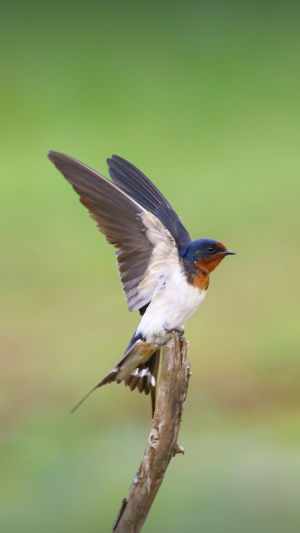Since ancient times, swallows have been regarded as auspicious birds.
Therefore, when people stop hunting and killing birds around them, swallows can be left alone. As swallows live near people, few animals can threaten their safety. However, the number of swallows, which have almost no natural predators and are not hunted by humans, has not only not increased but also shows signs of constant decrease. Why is this?
There are more than 75 species of swallows in the world, including House Swallows, White-rumped Rainbows, House Swallows, Rock Swallows, Gray Sand Swallows, Golden-rumped Swallows, and Hairy-footed Swallows.
The most preferred species are close to humans.
Every spring, house swallows contain nests under the mud eaves. The swiftlets on the island also start to spit for the first time. In the late stage of nest building, even blood spits out. Therefore, when collecting swiftlet nests, we often see the situation of "blood dripping in front of the nest becomes red".
Some female swiftlets die in their nests due to overwork!
The main habitat of the swiftlet is around the village. As a bird that feeds mainly on insects, the diet of the house swallow is mainly composed of scales. The recipes of swiftlets are mainly insects under Lepidoptera, Hymenoptera, and Hemiptera, which are considered "pests" in agriculture.
This is one of the reasons why people are more friendly to swallows.
House swallows, like most swallows, are migratory birds. They have a migratory habit. However, swallows do not migrate to escape from the cold. Rather, it is because the winter is relatively cold in the breeding grounds. Insects either die or hibernate. So the swallows have to migrate for food.
Among the birds in nature, swallows are one of the species with relatively strong breeding ability. Although the breeding period of house swallows is only about 3 months. But within these 3 months, it can breed two broods, one in April-June and one in June-July.
Normally, a house swallow can leave at least 10 offspring in a year. Remove about 10-20% of the accidents. At least 8 of them will grow up safely. Rarely do people actively hunt and kill swiftlets. Logically, the number of swiftlets should be increasing, so why is this not the case?
The number of creatures in nature does not skyrocket for no reason, unless it is an invasive species with an extremely high reproductive capacity, such as rabbits in Australia.
All other organisms have constraints in their respective ecologies, which keep their populations in a relatively stable state. So, what are the constraints that control the swallow population?
There are two main aspects: natural predators. Although it is rare to see swallows being hunted and killed, as small birds, they do not escape the constraints of natural enemies.
Among the swallows' natural enemies, raptors, cats, and mice under the hawk family are relatively common, although hawks are relatively less common in human settlements, and cats and rats only endanger swallows at night. This is what makes us mistakenly believe that swallows have no natural enemies.
Second: Accidents. Swallows will encounter many accidents in the process of growth. There are two common types: children and adults. When the swallows are in the nest, they need to excrete their droppings outside the nest.
And the nest is high from the ground.
At this time, it is easy for the swallow chicks to fall to the ground. For these swiftlet chicks who have not yet fledged. Even if they fall to the ground, we can pick them up and put them back. Usually, they will be thrown out again by the mother swallow.
Third: the sparrow mess. Since the beginning of the 21st century, ornithologists and bird conservationists have constantly found sparrows robbing the nests of swallows. Although swallows are somewhat larger than sparrows in terms of size, the sparrow's habit of swarming makes it difficult for swallows to fight. In general, sparrows rob the nests of swallows during the breeding season.
In this way, the swallow needs to rebuild its nest during the breeding season. By the time the nest is built, it will have missed the breeding season.
It is not that swallows do not have natural enemies. Rather, they have relatively few natural predators. And most of them are active at night, with the restraint of natural enemies.
With the restraint of natural predators, the number of swallows will not skyrocket due to the attrition on the migration path.
In recent years, the number of swallows has gradually declined in many places.
This has a lot to do with the decrease in food, habitat, nest damage, and competition from sparrows.





